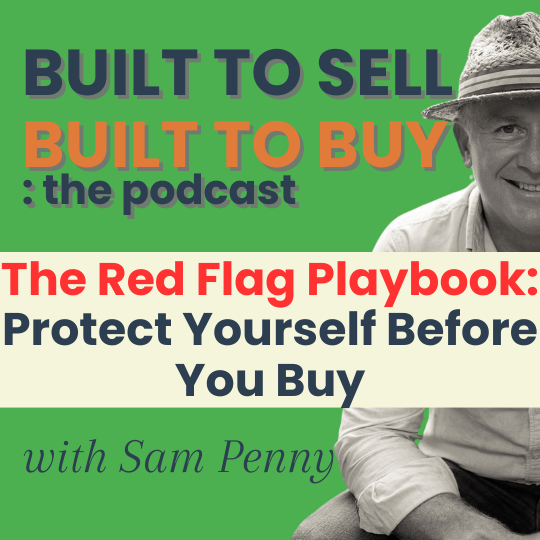
The Red Flag Playbook: Protect Yourself Before You Buy
Share
Thinking about buying a business? Before you fall in love with the profit numbers or the seller’s pitch, you need to ask yourself one question:
What could go wrong?
Because here’s the truth: the most expensive mistakes in business acquisitions aren’t made after the purchase — they’re made before the ink dries. They happen when you overlook risk, skip the deep questions, or assume the business will “just keep working” once you take over.
In this article, I’ll break down exactly how to spot the hidden risks that can wreck your deal — and show you how to price them into your offer so you don’t overpay or inherit chaos.
Why Risk Matters More Than Profit
Most buyers obsess over revenue and EBITDA. But those are just numbers — and numbers can lie, or at least mislead.
The truth is: buyers don’t walk away because of low profit — they walk away because of risk.
If you’re not actively identifying, interrogating, and pricing risk into your offer, you’re guessing. And in this game, guesses cost money.
The Three Types of Risk in Every Business Purchase
Every deal you consider comes with risk. But not all risk is created equal. To evaluate a business properly, you need to break risk into three key categories:
1. Operational Risk
- Is the owner the business? If they leave, does everything fall apart?
- Are there documented systems (SOPs)? Or is everything tribal knowledge?
- Is the team dependent on the founder? Will culture collapse after they go?
2. Financial Risk
- Are the P&Ls clean and consistent? Or are there unexplained spikes?
- Are ad-backs legitimate? Or are they hiding costs to inflate EBITDA?
- Is cash flow healthy? Or is growth masking deeper financial strain?
3. Transfer Risk
- Is there a documented transition plan? Or will you be left in the dark?
- Will key staff and customers stay? Or are they loyal only to the seller?
- Is the knowledge documented? Or does it walk out with the owner?
👉 Want help assessing these risks? Download my free Due Diligence Checklist.
Case Study: The Deal That Looked Great — Until We Dug Deeper
A recent deal I worked on looked perfect on paper: $1.2M in revenue, $360K in EBITDA, clean P&Ls, and a strong brand. Asking price? $1.26M (3.5x multiple).
But when we went deeper, we found:
- No documented systems or SOPs
- Owner still deeply involved in operations
- Overly aggressive ad-backs inflating profit
- No handover plan and staff loyalty tied to the seller
Instead of walking away, we structured the deal differently:
- Reduced price from $1.26M to $936K
- Paid $750K upfront, with the rest as a 12-month earn-out
- Required a 3-month transition with documented deliverables
- Added clawbacks for client churn
💡 That’s the power of identifying and pricing risk. We didn’t avoid the deal — we made it safer.
5 Smart Ways to Price Risk into Your Offer
- Reduce the Multiple – More risk = lower price.
- Use Earn-Outs and Holdbacks – Pay the rest only if performance holds.
- Tie Price to KPIs – If they claim clients will stay, make payment conditional.
- Mandate a Transition Period – Set clear expectations and deliverables.
- Negotiate in Writing – If it’s not in the contract, it doesn’t exist.
⚠️ Never absorb risk for free.
The Tools Every Smart Buyer Needs
You don’t need to be a forensic accountant. You just need the right tools and the discipline to use them.
These tools will help you stay objective, protect your capital, and avoid relying on gut feel.
Where Most Buyers Go Wrong
Let’s call it out. Most acquisition mistakes happen because of:
- 🤝 Trusting the seller too much without verifying
- 🏃 Rushing due diligence
- ❤️ Getting emotionally attached to the business
- 💰 Mistaking profit for low risk
Disciplined buyers win. Emotional buyers pay for the privilege.
Final Thought: Don’t Just Buy a Business — Buy a Future That Works
If you want to avoid costly mistakes and buy with clarity, confidence, and control — then risk needs to be your responsibility.
And if you want a second set of eyes on a deal you’re considering, I offer a free 30-minute strategy session where we gut-check the numbers, the risks, and the structure before you commit.
👉 Book your free strategy call now
🎧 Want More?
This article is based on the latest episode of the Built to Sell | Built to Buy podcast: "Identifying and Pricing Risk in a Business Purchase".
Listen now on Spotify or Apple Podcasts.
And don’t forget to explore all my free buyer tools and templates at sampenny.com.
Until next time — stay sharp, and be brave.
📚 Further Reading
- How to Maximise Your Business Valuation Before You Sell
- Don’t Buy a Business Without This: The Investor’s Business Checklist
- Exit Planning for Business Owners: What Buyers Want to See
- Business Coach vs Consultant: Who Will Actually Move the Needle?
- How to Evaluate a Business for Sale Like a Pro Investor
